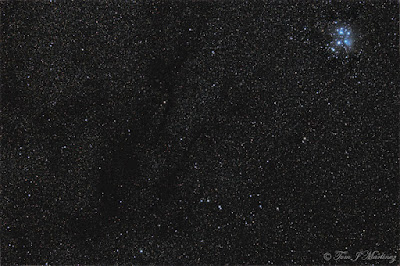
Most of the time, astrophotographers try to image dim objects, trying to make them brighter so that they are easier to see. However, there is one type of object in the night sky that emits no light. Because they emit no light, they appear as dark regions among the starry sky. At the upper right of the top picture is the famous Plieades Star Cluster, with its glowing reflection nebulae. The rest of the picture has many areas with very few stars. These are the so called "Dark Nebulae". At one time astronomers thought these were holes in the sky, letting us see space beyond the stars. We now know that instead of holes, what we are seeing is dark clouds of dust and gas so dense that they block the light of the stars behind them. If you can't see the dark nebulae, you need to adjust your monitors brightness setting.
****
The first person to prove this fact was Edward Emerson Barnard in the early part of the last century. E.E. Barnard was a self taught astronomer, who was the first person to use the newly invented camera on the night sky. He obtained thousands of photographic images of the Milky Way, then selected the 50 best for publication in his "Atlas of Selected Regions of the Milky Way". He approved each photograph for each and every book, therefore there were only about 700 books published. Each picture in the book is an actual photograph, not a printing press facsimile. So this is a rare and much sought after book.
****
Along with the photographs, in a seperate volume, there are charts with all the dark nebulae numbered by Barnard. There are 370, with each number starting with the letter B. In the above image, I have captured 15 of these nebulae. Click on the bottom chart to see each numbered object.
****
If you would like to see images from the Atlas, they are on the internet. The Georgia Institute of Technology Library and Informatin Center scanned the book and placed them here: http://www.library.gatech.edu/barnard/
****
Technical Photo Info
Camera: Canon XTi
Lens: Canon 70-200mm f/2.8 L IS
Focal Length setting: 70mm
Apeture setting: f/4
Exposure: 11 X 8 minutes totaling 88 minutes
Darks: 20
Flats: 20
Biases: 20
Mount: Celestron CGE
Guide Camera: Q-Guider by CCD-Labs
Aligned and Stacked in DeepSkyStacker with final processing in Photoshop


No comments:
Post a Comment